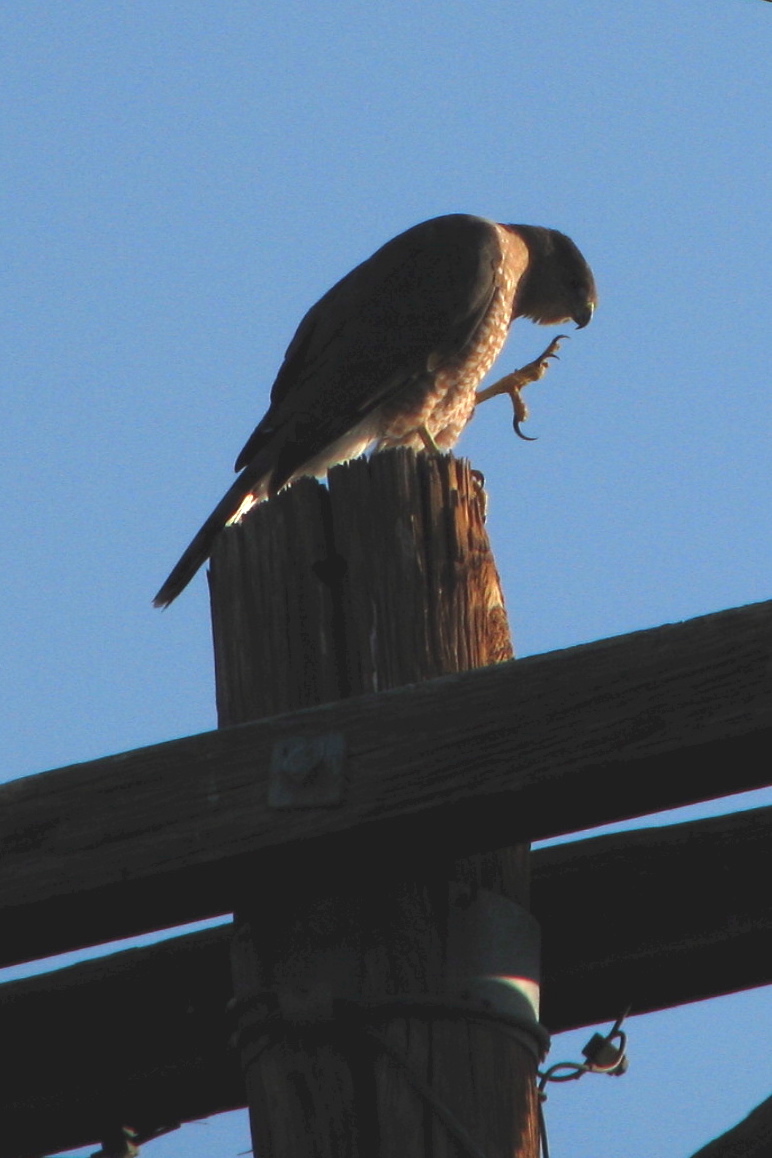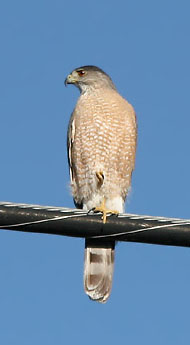Fierce-footed Cooper’s Hawk — Yard list
 A couple of mornings ago, we saw our first Cooper’s hawk of the season, swooping nimbly around the big backyard mesquite in an unsuccessful attempt at snagging a dove or finch from the feeders under the tree. It lit on the utility pole in the alley and, having an itchy face, primly scratched itself with a big, bird-catching foot.
A couple of mornings ago, we saw our first Cooper’s hawk of the season, swooping nimbly around the big backyard mesquite in an unsuccessful attempt at snagging a dove or finch from the feeders under the tree. It lit on the utility pole in the alley and, having an itchy face, primly scratched itself with a big, bird-catching foot.
Cooper’s hawks (Accipiter cooperii) are accipiters, a group of bird-eating hawk species characterized by medium to small size, spry flight (the better to capture other birds with), short rounded wings and a long tail useful for steering in flight. They inhabit a broad geographic area primarily in the lower 48 states, and a wide range of habitats, including temperate woodland, mesquite bosques, cottonwood stream-sides, as well as neighborhoods and parks. Cooper’s hawks are the most frequently encountered accipiter in Arizona.
If you put out a bird feeder for songbirds, you’re also feeding Cooper’s hawks (and their smaller relative, the Sharp-shinned hawk). Not because they eat seed, of course, but because they eat seed-eaters, like the finches and sparrows that stuff themselves at well-stocked feeders. Our yard hosts Cooper’s hawks most often during migration and in winter, when they lurk inconspicuously in the lower branches of trees, waiting for unaware prey to come within range. All accipiters are capable of tail-chasing smaller birds skilfully through foliage, and take prey either on the ground or in mid-air (see fierce foot above). It’s not uncommon for us to find a Cooper’s hawk under the canopy of the big mesquite on a chilly winter morning with breakfast in its fist, or a feather pool on the ground under where one has roosted and plucked its meal. They favor avian prey, but will take anything they can get, including rodents, invertebrates, reptiles, etc.
 Although the strong early morning light in the upper photograph makes it difficult to see, the reddish barring on our recent hawk’s breast and belly means it’s an adult; an immature would have brown dots and streaks instead. Its gray back shows it’s a male; the larger females are brownish above. Cooper’s have fierce red eyes and beetling brows, which give them a “You talkin’ to me?” sort of look.
Although the strong early morning light in the upper photograph makes it difficult to see, the reddish barring on our recent hawk’s breast and belly means it’s an adult; an immature would have brown dots and streaks instead. Its gray back shows it’s a male; the larger females are brownish above. Cooper’s have fierce red eyes and beetling brows, which give them a “You talkin’ to me?” sort of look.
Photos: top, E. Shock. Right: a very clear photo of an adult Cooper’s from T. Beth Kinsey’s Firefly Forest showing an excellent assortment of field-marks for the species: contrasting dark cap, red barred breast, bright yellow legs and barred tail with relatively wide white terminal band.
Etymology
In Latin, accipiter means “hawk”, from the verb accipere, which means “to take” as in “taking prey”, like the word “raptor”. The species name, cooperii, is named after ornithologist William C. Cooper (1798-1864), a New York scientist who described the Evening Grosbeak. In places where their ranges overlap, such as northern Arizona and New Mexico, a Cooper’s hawk would love to eat an Evening grosbeak.
